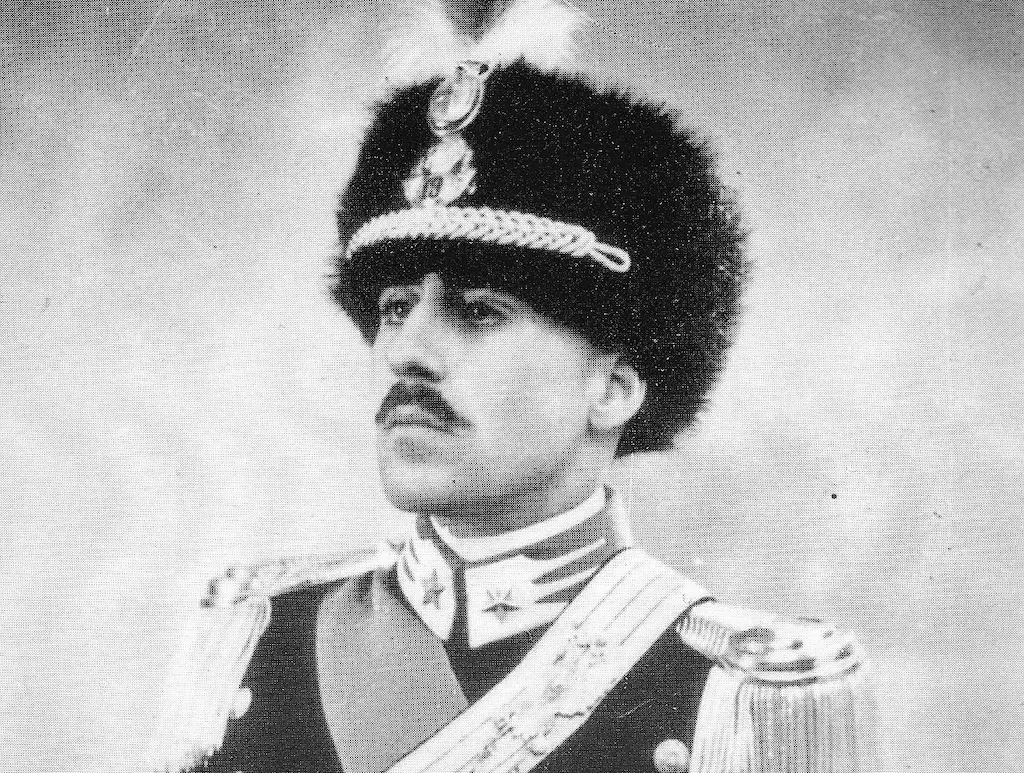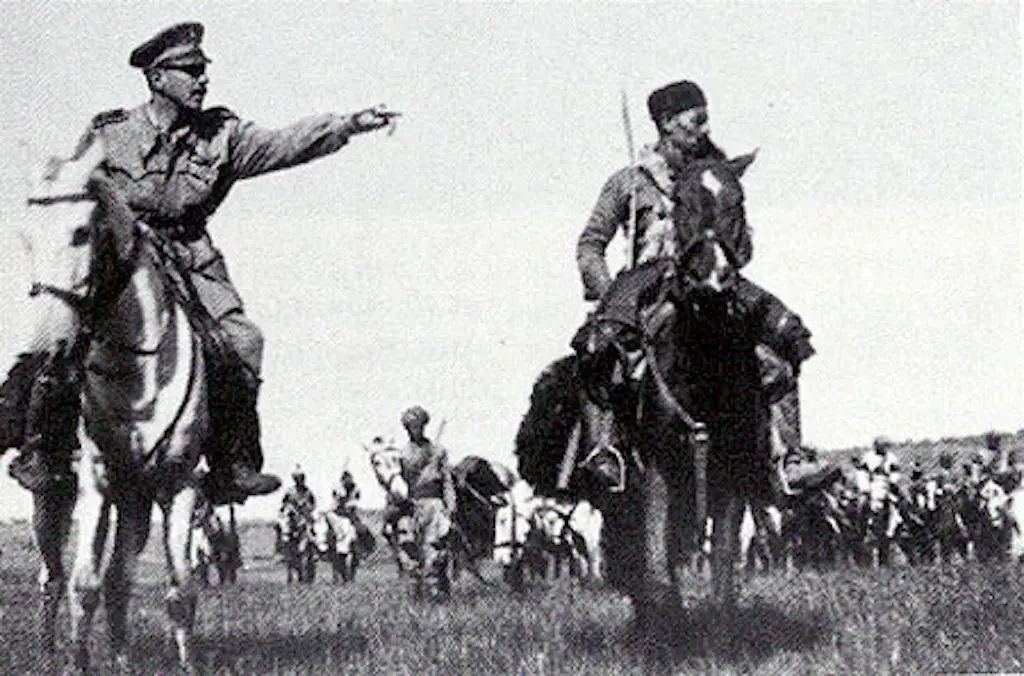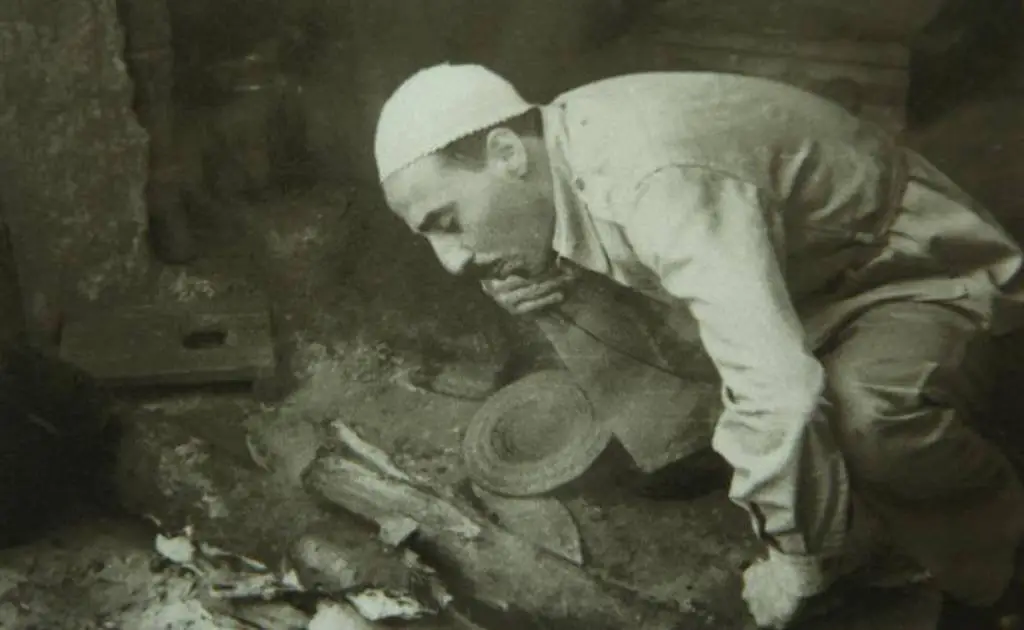Early life and the Abyssinian Campaign
Amedeo Guillet was born in Piacenza on 07 February 1909. His family raised him with strong military values and unconditional loyalty to the Italian monarchy and the House of Savoy. He joined the military academy in Modena and later entered the Regio Esercito as a Cavalry Lieutenant at the age of 22. Amedeo Guillet immediately proved to be a formidable man in many skill sets. His horse handling abilities provided him an opportunity to join the Italian equestrian team in the 1936 Summer Olympic games. However, Italy’s preparation for the invasion of Ethiopia prevented him from attending the Olympic Games. Instead, he transferred to Libya to train and command a squadron of Spahis.

Amedeo Guillet in 1935.
The Spahis were formidable Libyan mounted mercenaries, dressed in their peculiar traditional battle dress.
During this period, Guillet learned to speak Arabic by attending a local koranic school. Guillet deemed it essential to effectively communicate with his men in their mother tongue during battle.
In October 1935 the Italian invasion of Ethiopia started. Amedeo Guillet and his Spahis were immediately dispatched to the region. He distinguished himself in several battles against Ethiopian forces until he received a severe hand wound. At the end of the war in 1936, Air Marshal Italo Balbo provided him an award for his outstanding service.
Back home and the Spanish Civil War
Following hand surgery, he returned to Italy. Guillet spent his convalescence in Naples where he met Beatrice Gandolfo. The two soon fell in love and Amedeo expressed his wish to marry her. However, a recently passed law forbade unmarried officers to receive a promotion. Amedeo Guillet did not want to be seen as an officer marrying just for the sake of promotion so he made a more difficult choice.
Promotions for military accomplishments were permitted for unmarried men. So he decided to get one before marrying Beatrice. An opportunity arose when the Spanish Civil War broke out and Italy sent military contingents to aid the Nationalist Forces.
Guillet was not a fascist, but his aristocratic background and allegiance to the monarchy made him a fierce anti-communist. He joined an “Arditi” unit in 1937.
Guillet proved military valor once again in the battles of Santander and Teurel until he obtained a leg wound. Unfortunately, this put an end to his Spanish endeavor. The atrocities witnessed in Spain shook Guillet’s confidence in Italian leadership. It was further weakened by the implementation of the 1938 racial laws which he fiercely disapproved of.
Return to Abyssinia and the Devil Commander
In 1939 Amedeo Duke of Aosta, Viceroy of Ethiopia recalled Guillet to Africa. The Duke ordered Guillet to take command of a Colonial Cavalry unit and carry out anti-guerrilla missions in the region still opposed to Italian rule. Guillet’s unit, called Gruppo Bande Amahara a Cavallo, included a multi-ethnic unit made of Ethiopians, Eritreans and Yemenite riders. The unit was led by Italian officers and comprised of 1,500-1,700 men. During action against Ethiopian rebels in the region of Dougur Dubà, Guillet’s lost two horses in the battle. He kept fighting and utilized a machine gun to repel the enemies.

Amedeo with an important Ethiopian chief wearing. the lion mane headdress (1939).
He miraculously survived the action and received the Silver Medal for Military Valour. His men nicknamed him “Commundàr es Sciaitan” or Devil Commander, in reference to the apparent immortality of their Leader. His leadership by example, his respect, and fairness to his unit resulted in the complete trust and loyalty of his men.
As proof of this, not a single man of the Amhara bands ever deserted or betrayed Guillet. The Devil Commander proved his chivalrous behavior toward his enemies. When the Amhara bands captured and disarmed Ethiopian guerrilla fighters, Guillet refused to execute them. This is in sharp contrast with the directives dictated from Rome. Instead of the firing squad, Guillet offered the prisoners the opportunity to join his unit. The Amhara band soon grew in numbers.
East African Campaign
When Italy joined the Second World War, its colonies in Italian East Africa immediately became isolated from the motherland. They had little to no chance of receiving supplies or reinforcements. The only hope for the Italian forces in the theatre was to bog down British forces to allow Italian troops in Libya to take Egypt.

The Devil Commander with his Gruppo Bande in the Eritrean lowlands, 1940.
After some initial Italian success East African, one being the conquest of British Somaliland, the tide soon turned in favor of Commonwealth forces. In January 1941, the bulk of Italian forces in the north were retreating towards Argodat to establish a new defensive position. However, the Gazelle Force was in hot pursuit. This motorized British column threatened to intercept the Italians while on the retreat. Amedeo Guillet was tasked to slow the British pursuit to allow the Italian army time to establish new defenses.
On the morning of 21 January 1941 near Cheru, the Devil Commander on his white horse and the Gruppo Bande Amahara a Cavallos, charged the Gazelle Force’s rear. This action spread panic and disarray among the Gazelle force as Guillet’s men struck with sabers, pistols and hand grenades.
Saved By Renato Togni and His Men
After the first charge, the British regrouped and threatened to encircle the bulk of Guillet’s men. At this point, Lieutenant Renato Togni, waiting in reserve, charged the British with his 30 riders to buy time for Guillet to retreat. Heavy British gunfire met the charge, killing Togni and most of his men. However, this daring action allowed Guillet to retreat.
During the charge at Cheru, Guillet lost 800 men, killed or wounded, but he accomplished his mission. This was the last cavalry charge the British ever faced. And it allowed Amedeo Guillet to delay the British advance enough for the Duke of Aosta’s army to retreat to Argodat.
The Italian army surrendered in May 1941 and a resistance pocket in Gondar endured until November.
But the war was not over for Guillet. He decided to continue the fight.
Guerrilla Warfare
Guillet gathered around 100 of his former soldiers to initiate guerrilla warfare against the British. They were mostly Eritreans, who grew up under Italian rule and opposed the Ethiopians. Guillet and his men blew up bridges and hit key infrastructure in the region. He quickly gained the attention of British intelligence, who ordered Major Max Harari and Vittorio Dan Segre, an Italian Jew fighting in the British Army, to hunt down the Devil Commander.
In Hiding as Ahmed Abdalla Al Redai
The guerrilla war progressively depleted Guillet’s ranks and his health deteriorated as well. Amedeo Guillet suffered from malaria and the several wounds he received in battle began to take its toll. In autumn 1941 Guillet’s remaining loyal men convinced him to cease the guerrilla war and escape to neutral Yemen. Guillet agreed and disguised himself as a Yemenite. He took the name Ahmed Abdalla Al Redai and embraced Islam. During this timeframe, the British captured him twice, but he successfully hid his true identity and was released.

Devil Commander as Ahmed Abdalla Al Redai.
Escape Attempts
He managed to reach the port of Massawa with his Yemenite brother in arm Daifallah. They paid some smugglers for a passage on a ship to Yemen. But soon after their departure, the smugglers threw Amedeo and Daifallah offboard. They swam to the beach and realized they were alone in the Eritrean desert. They encountered some goat shepherds who beat them and stole their few remaining belongings. Miraculously, an Eritrean merchant traveling by camel saved them. The merchant invited them to his home where they were fed and provided some deserved rest.
When they recovered, Amedeo and Daifallah traveled back to Massawa and finally obtained their safe passage to Yemen. They arrived at the port of Hodeida at the end of 1941. Amedeo asked for refuge to the Yemenite authorities, but they arrested him when he unveiled his true identity.
Yemenite ruler, Imam Yahia, sympathetic to the Italian cause, summoned Amedeo Guillet. After listening to the incredible story of the Devil Commander, Imam Yahia asked Amedeo to serve under him and train his horses and men. Guillet remained in Yemen until June 1943. He ultimately managed to embark on a Red Cross ship repatriating Italian civilians.
Return to Italy
He returned to Italy in early September 1943. It was a volatile period for Italy. The country signed the armistice, and the Germans now occupied a divided Italy. Amedeo, loyal to the King, headed for Brindisi where the monarch and the government took refuge. He was granted an audience before King Vittorio Emanuele III. Amedeo Guillet recounted his incredible story and the King thanked him for his loyalty and impressive record.
Amedeo joined the Army Intelligence Service and performed several intelligence missions behind German lines until 1945.
After the war in 1946, Italy became a Republic. Faithful to the Monarchy decided to withdraw from military service and joined the Diplomatic Corps.
Amedeo Guillet After the War
Amedeo Guillet served as an Italian diplomat in Egypt, and Yemen. He also served as Italian Ambassador to Jordan, Morocco and finally India until 1975.
Beatrice, who he married in April 1944, was always by his side. In 1975, Amedeo retired in Knstown, Ireland where he enjoyed the tranquility of the area and his passion for fox hunting. While in Ireland, he became reacquainted with some of his former enemies. One of them, Max Harari, eventually became a close friend.

Guillet in Kentstown, Ireland with his horse in 2004. Image: Sabrina De Canio
After Beatrice’s death in the late 90s, he moved back to Italy. Amedeo Guillet passed away on 16 June 2010 in Rome, Italy at the age of 101. He is one of the most highly decorated men in Italian history, both as a civilian and military.
Reference Sources
Vittorio Dan Segre, La Guerra privata del tenente Guillet (1993).
Bastian Matteo Scianna, Forging an Italian hero? The late commemoration of Amedeo Guillet (2019)
